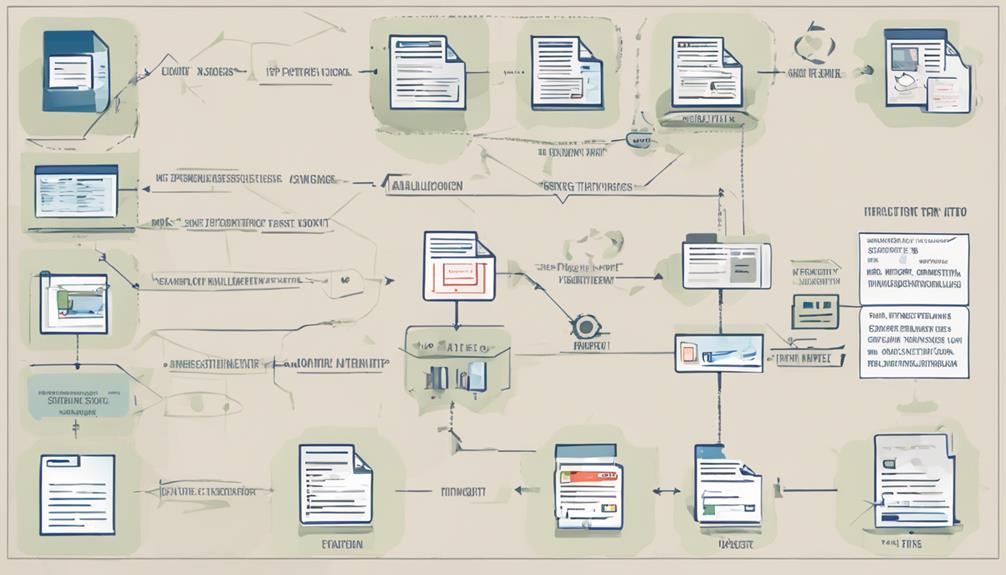When it comes to ensuring top-notch quality in SGML conversion, you must pay attention to the six key aspects that underpin success in this complex process. From accuracy and compliance to consistency and data integrity, each aspect plays a crucial role in delivering impeccable results. By understanding these key elements, you can navigate the intricacies of quality assurance in SGML conversion with finesse and precision, setting the stage for flawless outcomes.
Importance of Quality in SGML Conversion
When embarking on SGML conversion, the importance of maintaining high quality throughout the process cannot be overstated. Quality control is crucial to ensure that the converted data retains its integrity and accuracy. Every step in the conversion process, from initial analysis to final delivery, must adhere to strict quality standards to avoid errors and inconsistencies.
To maintain quality during SGML conversion, it is essential to implement rigorous quality control measures. This includes thorough testing at various stages of the conversion process to verify data accuracy and consistency. By establishing clear quality checkpoints, you can identify and rectify any issues promptly, ensuring the final output meets the desired standards.
Data accuracy is a cornerstone of successful SGML conversion. Any discrepancies or inaccuracies in the converted data can lead to misunderstandings, errors, and potential legal or financial implications. By prioritizing quality throughout the conversion process, you can safeguard against data inaccuracies and ensure a smooth transition to SGML format.
Quality Standards for SGML Conversion
To ensure the successful conversion of SGML data, adherence to stringent quality standards is paramount. Quality standards in SGML conversion encompass various aspects such as quality metrics and compliance with industry regulations. By establishing clear quality metrics at the outset of the conversion process, you can measure the accuracy, completeness, and consistency of the converted data. Compliance with quality standards ensures that the converted SGML data meets the required specifications and is error-free.
Process improvement is another crucial element of quality standards for SGML conversion. Regularly evaluating and refining the conversion process leads to higher efficiency and better outcomes. By identifying bottlenecks and implementing streamlined procedures, you can enhance the overall quality of the converted data while reducing time and costs.
Incorporating quality standards not only ensures the accuracy and integrity of the converted SGML data but also paves the way for continuous improvement and efficiency in the conversion process. Striving for compliance and process improvement guarantees a high-quality output that meets the standards set for SGML conversion.
Tools for Ensuring Quality in SGML Conversion
When ensuring quality in SGML conversion, it is crucial to utilize validation tools to check the accuracy and completeness of the converted data. Error detection methods play a significant role in identifying and correcting any inconsistencies or discrepancies during the conversion process. Additionally, conducting data integrity checks is essential for maintaining the overall quality and reliability of the SGML conversion output.
Validation Tools Importance
To ensure the highest levels of quality and accuracy in SGML conversion, the use of validation tools is paramount. Automated validation tools play a crucial role in quickly identifying inconsistencies, errors, or formatting issues in the SGML documents being converted. These tools can automatically check if the SGML files adhere to the defined Document Type Definition (DTD) or schema, ensuring that the converted documents meet the required standards.
In addition to automated validation, manual review is equally important in the SGML conversion process. Manual review involves human intervention to meticulously inspect the converted documents, ensuring that the content, structure, and formatting are accurately preserved during the conversion. This step helps in catching any errors or inconsistencies that automated tools might have missed. Combining automated validation with manual review provides a comprehensive approach to quality assurance in SGML conversion, ensuring that the converted documents are of the highest quality and meet the specified requirements.
Error Detection Methods
In order to maintain the integrity and accuracy of SGML conversion, a robust system of error detection methods is indispensable. Automated validation tools play a crucial role in identifying common errors such as tag mismatches, missing attributes, or structural inconsistencies. These tools can scan large volumes of data swiftly, flagging potential issues efficiently. However, while automated validation is efficient, it is essential to supplement it with manual review. Human intervention is crucial in catching nuanced errors that automated tools might overlook, such as contextual inaccuracies or inconsistencies in formatting. Manual review allows for a detailed examination of the content, ensuring that the converted SGML files adhere to the required standards accurately. Combining automated validation tools with manual review processes creates a comprehensive error detection mechanism that enhances the overall quality of SGML conversion. By leveraging both automated and manual methods, organizations can minimize errors, maintain data accuracy, and uphold the integrity of their SGML conversion processes effectively.
Data Integrity Checks
For ensuring the quality and reliability of SGML conversion, the implementation of robust data integrity checks is imperative. Metadata validation plays a crucial role in ensuring that the information describing the content is accurate and consistent throughout the conversion process. By verifying metadata against predefined schemas or rules, errors such as missing or incorrect metadata can be detected and rectified promptly.
Document structure is another key aspect that data integrity checks focus on during SGML conversion. Ensuring that the hierarchy, relationships, and formatting of the document elements are maintained correctly is essential for preserving the integrity of the content. Data integrity checks can identify issues such as missing tags, incorrect nesting of elements, or structural inconsistencies that may arise during the conversion process.
Quality Control Practices in SGML Conversion
Implementing effective quality control practices is crucial in ensuring the accuracy and consistency of SGML conversion processes. To achieve this, incorporating process improvement strategies is essential. Regularly reviewing and refining the conversion procedures can help identify areas for enhancement, leading to higher quality outcomes. Additionally, establishing performance metrics is vital for measuring the success of the quality control practices. By defining key performance indicators such as error rates, turnaround times, and adherence to standards, you can systematically evaluate the effectiveness of the conversion process and make informed decisions for improvement.
Conducting thorough quality checks at various stages of the SGML conversion process is imperative. Implementing validation tools and manual checks can help detect errors early on, preventing issues from propagating further downstream. Creating detailed quality control checklists tailored to the specific requirements of the SGML conversion project can serve as a roadmap for ensuring accuracy and consistency. By diligently following these quality control practices, you can enhance the overall quality of SGML conversion outputs and deliver reliable and error-free results.
Outsourcing for Quality SGML Conversion
Considering outsourcing for quality SGML conversion can offer numerous benefits to your organization. When selecting a vendor for SGML conversion, it’s crucial to assess their experience, expertise, and track record. Look for vendors with a proven history of successful SGML projects and a deep understanding of industry standards.
Cost analysis is another important factor to consider when outsourcing SGML conversion. Evaluate the pricing structures of different vendors and compare them against the quality of service they provide. While cost is a significant consideration, it should not be the sole determining factor. Opt for a vendor that offers a balance between cost-effectiveness and high-quality conversion services.
When outsourcing SGML conversion, ensure that the vendor aligns with your organization’s goals and values. Effective communication and a clear understanding of project requirements are essential for a successful partnership. By carefully selecting a vendor and conducting a thorough cost analysis, you can streamline the SGML conversion process and achieve high-quality results for your organization.
Training for Quality SGML Conversion
Amidst the dynamic landscape of SGML conversion, ensuring high-quality results hinges significantly on the proficiency and expertise of the individuals involved in the process. To achieve excellence in SGML conversion, comprehensive training is essential. Hands-on workshops provide an interactive learning environment where participants can delve into practical exercises, gaining firsthand experience in handling SGML conversion tools and techniques. These workshops offer a valuable opportunity to troubleshoot common issues and enhance skills under the guidance of experienced instructors.
In addition to hands-on workshops, online tutorials serve as a convenient resource for continuous learning. These tutorials can be accessed anytime, anywhere, allowing individuals to expand their knowledge at their own pace. Online platforms offer a variety of modules covering different aspects of SGML conversion, from basic concepts to advanced strategies. By combining hands-on workshops with online tutorials, individuals can develop a deep understanding of SGML conversion processes and best practices, ultimately contributing to the delivery of high-quality outcomes.
Frequently Asked Questions
Can SGML Conversion Software Handle Complex Formatting Requirements?
Yes, SGML conversion software can handle complex formatting requirements efficiently. It excels in handling tables with precision and managing images seamlessly. This capability ensures that your content retains its structure and visual elements accurately during the conversion process.
How Can Metadata Be Preserved During SGML Conversion?
Imagine metadata as the heart of a document, vital for its essence. To preserve metadata during SGML conversion, ensure accuracy by validating data integrity, maintaining structural consistency, and using reliable conversion tools.
Is It Possible to Maintain Hyperlinks in SGML Conversion Process?
Yes, you can maintain hyperlinks during SGML conversion, ensuring seamless navigation. This process involves meticulous attention to hyperlink preservation and careful handling of metadata. By following these steps, you can retain the integrity of your content.
What Measures Are Taken to Ensure Data Security in SGML Conversion?
To ensure data security in SGML conversion, measures like data encryption and access control are implemented. Data encryption safeguards information during the process, while access control limits unauthorized entry, enhancing overall security.
How Can SGML Conversion Handle Non-Standard or Proprietary Document Formats?
When handling non-standard or proprietary formats in SGML conversion, ensure legacy compatibility by extracting documents efficiently. Maintain data accuracy by understanding file structures thoroughly. This approach guarantees a seamless transition while preserving the integrity of the original content.



